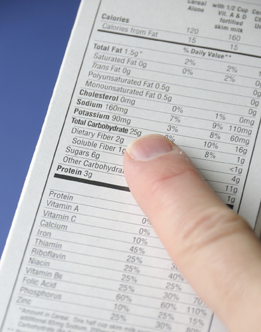Lesson 1
1. Lesson 1
1.6. Explore 2
Module 6: Proportional Reasoning

iStockphoto/Thinkstock
In some cases, the unit rate is not the most appropriate rate to use to represent or to compare items. Nutritional content of foods is one example where the unit rate may not be the best choice. The nutrition-facts label on food is based on a specific serving size. Representing the nutritional content as a rate per serving as opposed to a unit rate (e.g., amount per gram) helps consumers to be better informed as to the nutritional content of what they are eating.
For example, the serving size of a particular brand of cereal is ![]() of a cup, or 49 g. The nutrition facts on the side of the box are based on this serving size. The table shows the nutrition content given as a rate (per serving) and as a unit rate (per gram).
of a cup, or 49 g. The nutrition facts on the side of the box are based on this serving size. The table shows the nutrition content given as a rate (per serving) and as a unit rate (per gram).
|
Rate (per serving) |
Unit Rate (per gram) |
|
|
1 g of cereal |
|
Calories |
200 cal to
|
4.08 cal/g
|
|
Total Fat |
7 g to
|
0.14 g/g
|
|
Sugar |
15 g to
|
0.31 g/g
|
|
Protein |
4 g to
|
0.08 g/g
|
Is it easier to visualize ![]() of a cup of cereal or 1 g of cereal? For representing the nutritional content of foods, it is more appropriate to use a rate per serving as opposed to a unit rate.
of a cup of cereal or 1 g of cereal? For representing the nutritional content of foods, it is more appropriate to use a rate per serving as opposed to a unit rate.